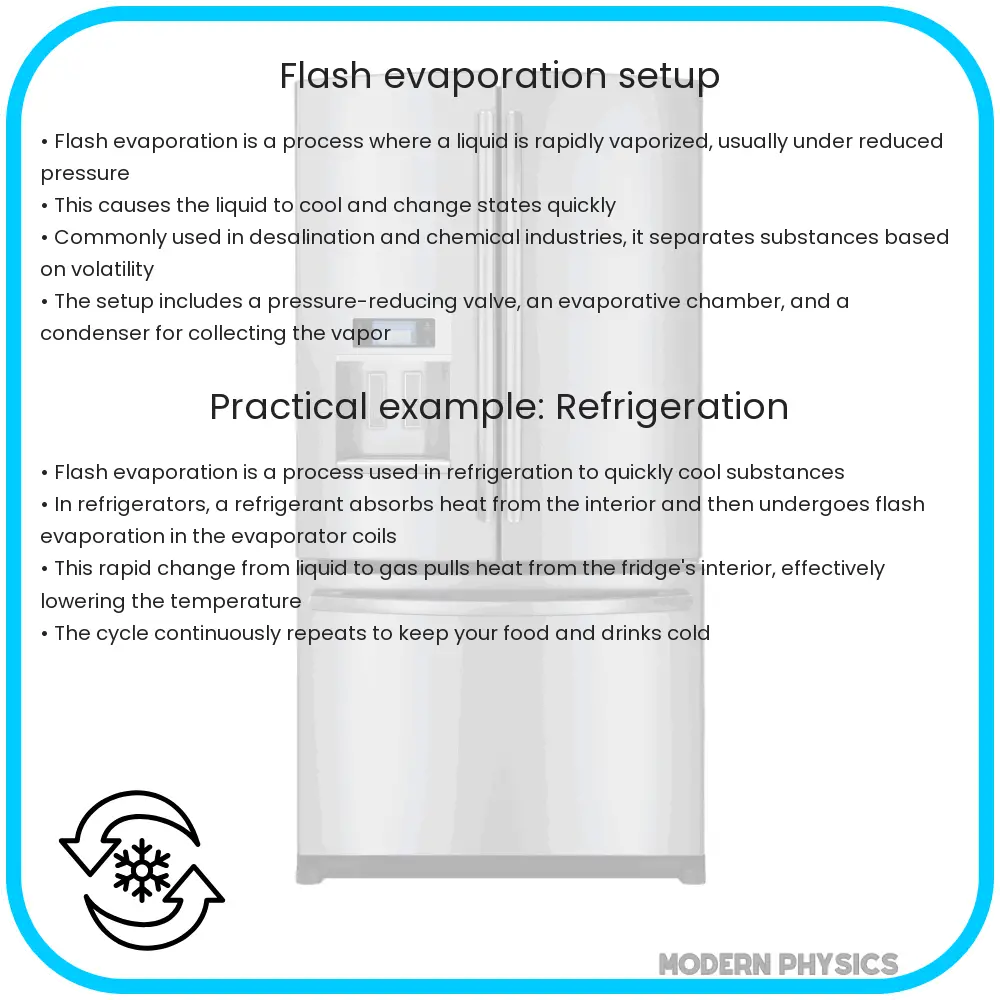Explore the efficiency, design, and thermodynamics of flash evaporation in industrial applications, with insights into optimization and usage.

Understanding Flash Evaporation: An Overview
Flash evaporation, a critical process in industrial and environmental applications, involves the rapid vaporization of a liquid. This phenomenon occurs when a liquid is suddenly exposed to a pressure lower than its vapor pressure, leading to a portion of the liquid rapidly transforming into vapor. This article delves into the efficiency, design considerations, and thermodynamics of flash evaporation setups.
Efficiency of Flash Evaporation
The efficiency of flash evaporation is a measure of how effectively the system converts liquid into vapor. This efficiency is influenced by several factors, including the heat transfer rate, the specific heat of the liquid, and the operational pressure and temperature. High efficiency in flash evaporation means less energy consumption and increased process throughput, making it a vital aspect in industrial applications such as desalination and chemical processing.
Design Considerations
When designing a flash evaporation system, several key factors must be considered:
- Material Selection: The choice of materials for construction is crucial due to the corrosive nature of many fluids and the high temperatures involved. Stainless steel and other corrosion-resistant materials are commonly used.
- Pressure Control: Maintaining the appropriate pressure is essential for efficient vaporization. This involves sophisticated control systems to manage the pressure within the evaporator.
- Heat Exchange Efficiency: The design should optimize heat transfer for maximum efficiency. This involves selecting the right heat exchanger type and configuring it appropriately for the specific application.
Thermodynamics of Flash Evaporation
The thermodynamics of flash evaporation is governed by the principles of energy conservation and phase change. The process can be analyzed using the enthalpy balance, which considers the heat required to bring the liquid to its boiling point and the latent heat of vaporization. The equation can be represented as:
Q = ml(hv – hl)
where Q is the heat input, ml is the mass of the liquid, hv is the enthalpy of the vapor, and hl is the enthalpy of the liquid. Understanding these thermodynamic principles is essential for optimizing the flash evaporation process.
Optimization Strategies in Flash Evaporation
Optimizing a flash evaporation system involves several strategies to enhance efficiency and productivity. These include:
- Preheating the Feed: Preheating the liquid feed to near its boiling point reduces the energy required for vaporization.
- Multiple-Stage Flash Evaporation: Using multiple stages where the pressure is progressively reduced in each stage can significantly increase the efficiency of vaporization.
- Energy Recovery: Implementing energy recovery systems, such as using the heat of the condensed vapor to preheat the feed, can significantly reduce energy consumption.
Applications of Flash Evaporation
Flash evaporation finds its applications in various industries:
- Desalination: It is widely used in desalination plants to convert seawater into potable water by removing salts and minerals.
- Chemical Industry: In the chemical industry, flash evaporation is used for concentrating solutions and recovering solvents.
- Food and Beverage Processing: The process is employed in the concentration of juices and dairy products, ensuring flavor retention and energy efficiency.
Environmental and Safety Considerations
While flash evaporation is efficient, it must be managed carefully with respect to environmental and safety concerns. Proper handling of the chemicals and the treatment of waste products are essential to prevent pollution. Additionally, safety measures must be in place to handle the high pressures and temperatures involved in the process.
Conclusion
Flash evaporation is a versatile and efficient process critical in many industrial applications. Its design and operational efficiency hinge on a thorough understanding of thermodynamics, material science, and process engineering. By optimizing the design and operation of flash evaporation systems, industries can achieve higher efficiency, reduced energy consumption, and lower environmental impact. As technology advances, the potential for more innovative and sustainable uses of flash evaporation in various sectors looks promising, underlining its importance in modern industrial processes.
